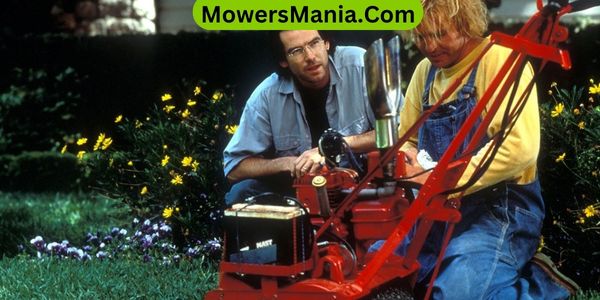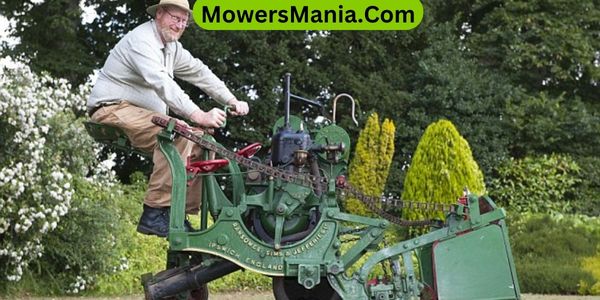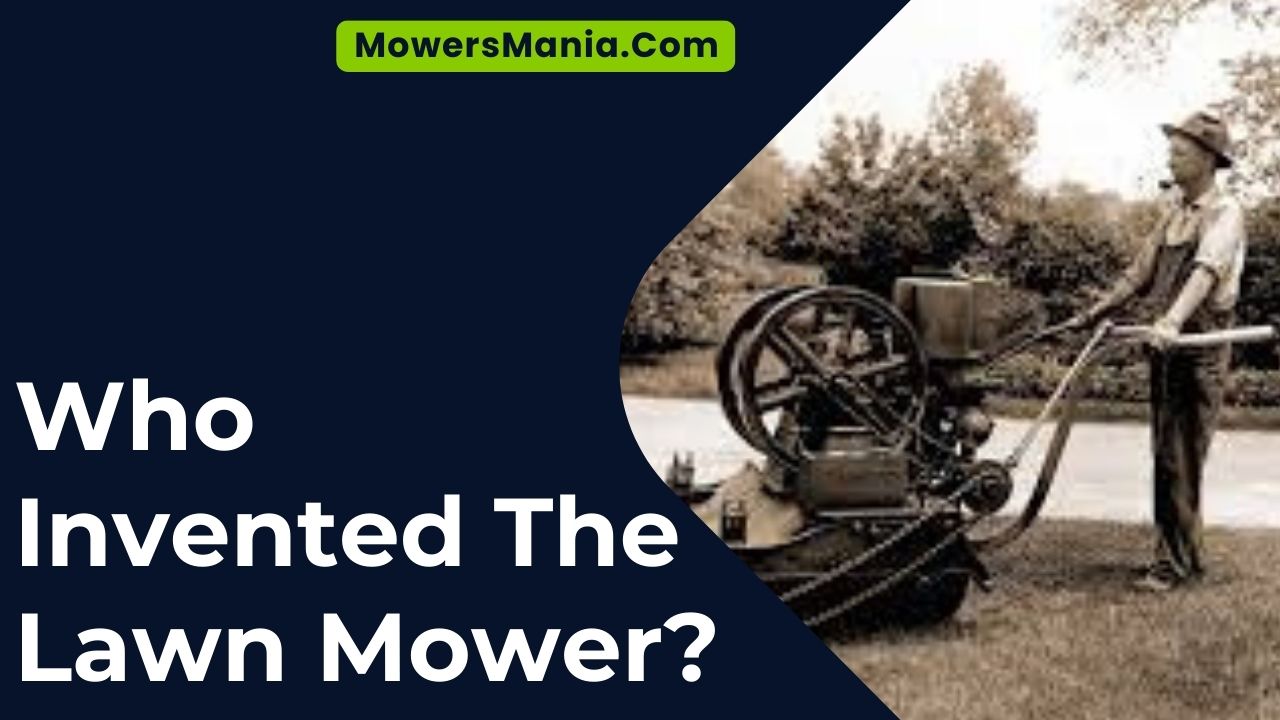If you’ve ever wondered who came up with the idea of the lawn mower, you’re in for an interesting journey.
From the early grass cutting tools to the modern innovations, the invention of the lawn mower has evolved over time.

Let’s explore the fascinating history behind the creation of this essential gardening tool.
Early Grass Cutting Tools
Early civilizations used simple scythes and sickles to maintain their grassy areas. These tools, with their curved blades, were effective for cutting grass and small vegetation, but they required considerable manual labor.
As time passed, there was a demand for more efficient ways to manage grassy spaces. This need led to the invention of the first mechanical grass cutting tool in 1830 by Edwin Budding, a British engineer.
Budding’s invention, the lawn mower, was a revolutionary step in grass maintenance. It consisted of a reel blade mechanism that was pushed from behind, allowing for a more uniform and efficient grass cutting process.
This innovation significantly reduced the time and effort required for grass cutting, making it more manageable for larger areas. The lawn mower quickly gained popularity and was further improved upon, eventually leading to the modern lawn mowers we use today.
Budding’s invention marked a significant shift in grass cutting methods, allowing for more systematic and precise maintenance of grassy areas.
The First Patent for a Lawn Mower
You should know that the first patent for a lawn mower was granted in 1830 to Edwin Budding, a British engineer. Budding designed a mower with a reel blade that rotated against a bed knife, a concept still used in modern mowers.
His invention aimed to efficiently cut the grass on sports grounds and large gardens. Budding’s mower was an improvement over existing grass-cutting tools, as it provided a more even and uniform cut.
Budding’s patent described the mower as ‘a new combination and application of machinery for the purpose of cropping or shearing the vegetable surface of lawns, grass-plots, and pleasure grounds.’
This marked a significant milestone in the history of lawn care, as it revolutionized the way grass was maintained and led to the widespread use of lawn mowers.
The patent granted exclusive rights to Budding to manufacture and sell his invention, which allowed him to commercialize the lawn mower and bring it to a wider market.
This marked the beginning of the lawn mower as we know it today, and Budding’s innovation laid the foundation for the modern lawn care industry.
Evolution of Manual Lawn Mowers

Throughout history, people have relied on manual lawn mowers to maintain their lawns. These simple yet effective tools have undergone significant evolution over the years, shaping the way we care for our outdoor spaces.
- Invention of the Cylinder Mower: The early 19th century saw the invention of the cylinder mower, a significant advancement from the scythe or the sickle. This type of manual mower featured a set of blades arranged in a cylinder to cut grass with precision, revolutionizing lawn maintenance.
- Introduction of Reel Mowers: In the late 19th and early 20th centuries, reel mowers became popular. These manual mowers had a cutting reel in the front and a set of rollers at the back, allowing for a cleaner and more even cut. They were often made of cast iron and required physical strength to operate.
- Development of Lightweight Materials: Modern manual lawn mowers are made from lightweight materials such as aluminum and carbon fiber, making them easier to maneuver and operate. These advancements have made manual lawn mowers more user-friendly and efficient for homeowners seeking an eco-friendly lawn care option.
Introduction of the First Steam-Powered Mower
So, you’re probably wondering about the origins of the first steam-powered mower.
It’s an interesting story that sheds light on the impact of technological advancements on lawn care.
Plus, it’s fascinating to see how these early innovations paved the way for the evolution of modern mowers.
Steam-Powered Mower Origins
The introduction of the first steam-powered mower revolutionized lawn maintenance, enabling faster and more efficient grass cutting. This innovation marked a significant leap forward in the history of lawn care, paving the way for mechanized solutions that transformed the way people maintained their outdoor spaces.
The origins of steam-powered mowers can be traced back to the 19th century, when inventors sought to harness the power of steam engines for various applications, including lawn mowing.
Steam-powered mowers were initially large and cumbersome machines, often requiring a team of operators to maneuver them across expansive lawns.
These early steam-powered mowers laid the groundwork for further advancements in lawn mower technology, ultimately leading to the development of more compact and user-friendly models for the mass market.
Impact on Lawn Care
When you consider the introduction of the first steam-powered mower, its impact on lawn care becomes evident. The invention revolutionized the way lawns were maintained, making it easier and more efficient to keep grass trimmed.
With the steam-powered mower, larger areas of grass could be cut in a shorter amount of time, reducing the labor required for lawn maintenance. This led to the expansion of parks, gardens, and other green spaces, as it became more feasible to keep them well-groomed.
The introduction of the steam-powered mower also contributed to the development of landscaping as a profession, as it allowed for more intricate and precise lawn designs to be implemented.
Evolution of Mowers
You can trace the evolution of mowers back to the introduction of the first steam-powered mower. This innovation marked a significant shift in lawn care technology, revolutionizing the way grass and lawns were maintained.
The introduction of the steam-powered mower brought about several key advancements:
- Efficiency: Steam power allowed mowers to cover larger areas in a shorter amount of time, making lawn maintenance more efficient and less labor-intensive.
- Precision: The steam-powered mower introduced greater precision in cutting grass, resulting in more uniform and well-maintained lawns.
- Industrialization: The advent of steam-powered mowers paved the way for industrial-scale lawn care, allowing for the maintenance of larger green spaces such as parks and estates.
Gasoline-Powered Lawn Mowers

Let’s talk about the evolution of gasoline-powered mowers and how they revolutionized lawn care.
You’ll also discover the impact of these mowers on the environment and how manufacturers are addressing environmental considerations.
It’s important to understand the advancements in this technology and their implications for modern landscaping practices.
Evolution of Gas Mowers
The gas-powered lawn mower revolutionized lawn care, offering a more efficient and powerful alternative to manual and electric mowers.
The evolution of gas mowers has seen significant advancements in technology and design, catering to the diverse needs of homeowners and landscaping professionals.
Here are three key aspects of the evolution of gas mowers:
- Engine Efficiency: Over time, gas mower engines have become more fuel-efficient, reducing emissions and operating costs while delivering increased power for cutting through tough grass and uneven terrains.
- Innovative Features: Modern gas mowers are equipped with innovative features such as self-propulsion, variable speed controls, and enhanced mulching capabilities, providing users with greater convenience and versatility in lawn maintenance.
- Environmental Considerations: Manufacturers are increasingly focusing on developing gas mowers with lower emissions and eco-friendly technologies, aligning with the growing emphasis on sustainability and environmental responsibility in lawn care practices.
Impact on Lawn Care
Gasoline-powered lawn mowers have significantly transformed the efficiency and speed of lawn care maintenance. These mowers provide powerful cutting capabilities, allowing you to tackle larger areas of grass with ease.
The increased horsepower and cutting width make it possible to cover more ground in a shorter amount of time, freeing you up to focus on other aspects of yard maintenance.
Additionally, the convenience of gas-powered mowers means you don’t have to worry about running out of battery power mid-mow, enabling you to finish the job without interruptions. However, it’s important to note that these mowers also require regular maintenance and fuel refills.
Environmental Considerations
When maintaining your lawn with a gasoline-powered mower, it’s essential to regularly inspect and maintain the engine to minimize environmental impact.
Here are three crucial environmental considerations to keep in mind:
- Regular Maintenance: Ensure the mower’s engine is properly tuned and maintained, including changing the oil and air filter as recommended by the manufacturer. This helps reduce emissions and improves fuel efficiency.
- Proper Fueling: Use fuel containers equipped with a spill-proof spout to prevent gasoline spills, which can harm the environment. Additionally, always fill the tank on a hard surface to avoid spills onto the grass or soil.
- Emissions Control: Consider upgrading to a mower with a catalytic converter or a four-stroke engine, as these options produce fewer emissions and are more environmentally friendly.
Innovations in Electric Lawn Mowers
Electric lawn mowers have become increasingly popular for their environmental friendliness and ease of use. Innovations in electric lawn mowers have focused on improving battery life, power, and efficiency.
Modern electric mowers are equipped with lithium-ion batteries that offer longer run times and faster charging, eliminating the need for gas or oil. These mowers are also quieter, emitting minimal noise and vibration compared to traditional gas-powered mowers.
Furthermore, manufacturers have integrated advanced cutting technologies, such as mulching and self-propulsion, into electric models, enhancing their performance and user experience.
One notable innovation is the development of robotic electric lawn mowers. These autonomous mowers are equipped with sensors and GPS technology, allowing them to navigate the lawn and mow grass independently.
Some models even return to their charging stations automatically. This hands-free approach to lawn maintenance saves time and effort for homeowners.
In addition, electric lawn mowers are being designed with eco-friendly materials, contributing to sustainability.
With ongoing advancements, electric lawn mowers are revolutionizing the way people maintain their lawns, offering a cleaner, quieter, and more convenient alternative to traditional gas-powered mowers.
Modern Features and Innovations

Incorporating advanced cutting-edge technology, modern lawn mowers now offer a range of innovative features for improved efficiency and ease of use.
- Self-Propulsion: Many modern lawn mowers are equipped with self-propulsion technology, reducing the effort required to push the mower across the yard. This feature is especially beneficial for larger lawns, minimizing the physical strain on the user.
- Smart Technology Integration: Some advanced lawn mowers now integrate with smartphone apps, allowing users to remotely control the mower, schedule mowing times, and receive maintenance alerts. This seamless integration of technology enhances convenience and provides users with greater control over their lawn care.
- Battery-Powered Operation: With the increasing focus on environmental sustainability, battery-powered lawn mowers have gained popularity. These mowers offer cordless operation, eliminating the inconvenience of tangled cords while reducing noise pollution and emissions. Additionally, advancements in battery technology have extended the runtime of these mowers, allowing for efficient and uninterrupted lawn maintenance.
These modern features and innovations have significantly transformed the lawn care experience, making it more convenient, efficient, and environmentally friendly.
Frequently Asked Questions [FAQs]
What Are the Environmental Impacts of Using Gasoline-Powered Lawn Mowers?
Using gasoline-powered lawn mowers has significant environmental impacts. They emit pollutants like carbon monoxide, nitrogen oxides, and volatile organic compounds, contributing to air pollution and greenhouse gas emissions. Consider using electric or manual alternatives.
How Has the Design of Manual Lawn Mowers Evolved Over Time?
Over time, the design of manual lawn mowers has evolved to be more efficient and user-friendly. They have become lighter, easier to maneuver, and require less physical effort to operate, making lawn maintenance simpler.
What Were Some of the Early Challenges Faced by Inventors of Steam-Powered Mowers?
When inventors first developed steam-powered mowers, they faced challenges such as creating a reliable steam engine small enough for the mower, managing the weight of the machinery, and ensuring safe operation.
How Do Modern Electric Lawn Mowers Compare in Terms of Performance and Efficiency to Gasoline-Powered Mowers?
Modern electric lawn mowers provide comparable performance and efficiency to gasoline-powered mowers. They offer lower maintenance, quieter operation, and reduced emissions, making them a convenient and eco-friendly choice for maintaining your lawn.
What Are Some of the Latest Technological Innovations in Modern Lawn Mowers?
In terms of technological innovations, modern lawn mowers have seen advancements such as battery-powered electric models, improved self-propulsion systems, and enhanced cutting blades. These innovations have led to more efficient and user-friendly mowing experiences.
Conclusion
So, next time you’re out mowing the lawn, take a moment to appreciate the history and evolution of the lawn mower.
From early grass cutting tools to modern electric and gasoline-powered machines, the invention of the lawn mower has come a long way.
With constant innovations and improvements, it’s clear that the humble lawn mower has had a significant impact on how we maintain our outdoor spaces.



